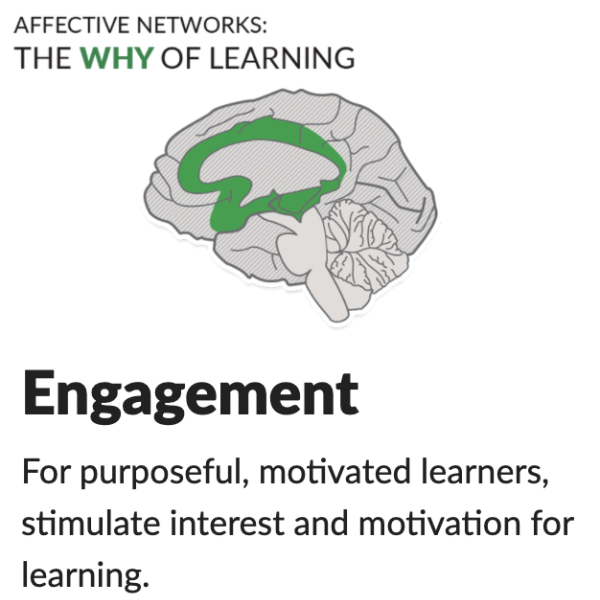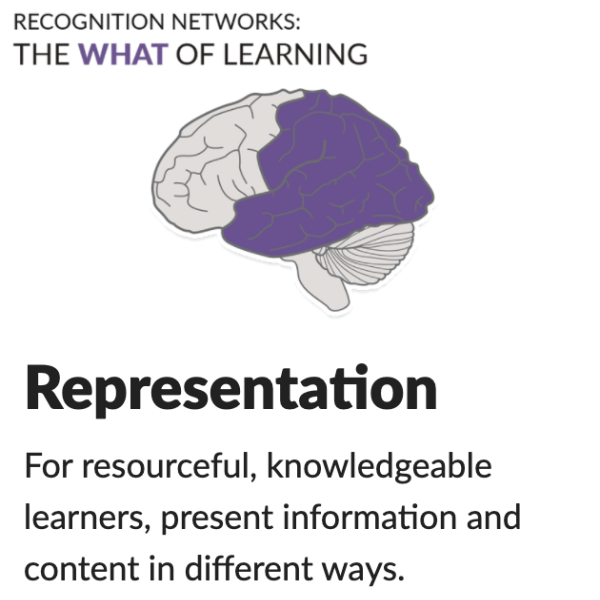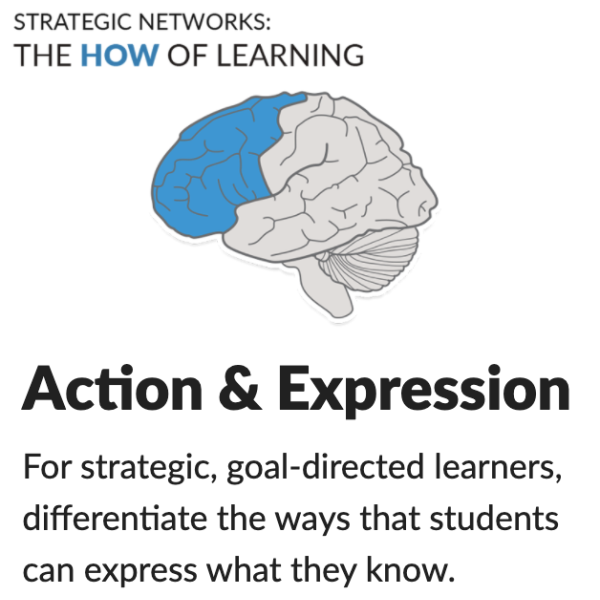Universal Design for Learning (UDL) is a set of diversity, equity, and inclusion principles that help instructors incorporate students’ motivations and commitments into their courses, while mitigating barriers to learning (that are within the instructor’s control). It is based on facilitating students’ access to learning opportunities through accessible content, student-centered pedagogy, and adaptive course design. (See CAST.org [CAST is the organization that specializes in UDL].)
Applying UDL entails examining or designing a course from a position of empathy with students. Among other things, it includes considering students’ previous learning experiences, potential contributions to the class, life pressures, disabilities, motivations, and commitments. Its three main (somewhat overlapping) principles are to provide multiple means of:



- Engagement - Motivate student engagement by purposefully fostering students’ agency, integrating collaboration, and promoting self-regulation in the learning process;
- Representation - Help students develop resourcefulness by presenting content in multiple ways, highlighting patterns of thinking, and maximizing transfer between topics and disciplines; and
- Action and Expression - Support students’ development of strategic thinking by allowing them to set goals, express their learning in multiple ways, and monitor their own progress.
Teaching Strategies for UDL
University level courses that follow UDL principles often use teaching strategies that inherently help mitigate common barriers to learning while forefronting students’ agency, existing capabilities, potential contributions, and motivation to learn from a variety of experiences and materials. The CAST.org website has some graphic organizers with general guidelines for teaching strategies that instructors can use as they decide which area of their course they want to improve through UDL. The following videos from Oakland University in Michigan are brief introductions to those student-centered teaching strategies.
UDL in Course Design, Communications, and Materials
Besides teaching strategies, UDL can also be integrated into your pedagogy through changes to your course design, communications, and materials. The following list of common barriers and strategies highlights some of these. To make this manageable, we suggest you explore sections of the list that are common barriers to student learning in your course. Choose 1-2 strategies that you might be able to incorporate into your course this term (this is called “Plus 1” in Tobin and Behling’s 2018 book on UDL), and then discuss those with your peers and us at Instructional Development.
Put the needs of students with learning disabilities and/or mental health issues foremost in planning assessments and delivering content. Students with “hidden” disabilities (like dyslexia, ADD, and depression) are very prevalent in higher education and often overlooked by instructors unless a student has an official accommodation letter (see the UCSB Disabled Students Program resources for faculty). You can support students through:
- frequent and transparent communication in multiple media (text, visual, email, website),
- easy/anonymous ways for students to communicate ideas for improving access to materials and opportunities for participation,
- formative assessments with somewhat flexible due dates,
- recording lectures and posting notes or slide,
- promoting student services for wellbeing,
- creating somewhat flexible summative assessments and/or deadlines (where appropriate),
- integrating digital and multimedia options for participating and accessing/reviewing course content,
- and using a predictable weekly pattern to help students manage their course workload.
Put the needs of physically disabled students foremost in planning and delivery of content (see the UCSB Disabled Students Program resources for faculty). Nobody likes to be caught out by students with physical disabilities who cannot access materials or participate fully in class interactions. You can support students through:
- ADA compliant course policies (e.g. accommodations),
- caption/transcribe videos (e.g. in GauchoCast or Zoom),
- formatting documents, webpages, and slides for screen readers,
- using colors and font that are good for visual and cognitive impairments (e.g. color blindness and dyslexia),
- providing easy/anonymous ways for students to communicate that they didn’t feel that content was accessible,
- formative assessments with somewhat flexible due dates,
- recording lectures and posting notes or slide,
- promoting student services for wellbeing,
- creating somewhat flexible summative assessments and/or deadlines (where appropriate),
- integrating digital and multimedia options for participating and accessing/reviewing course content,
- and using a predictable weekly pattern to help students manage their course workload.
Social and Cultural Issues
These issues are as varied as each individual person, but here are some common strategies to use based on maximizing student agency to build motivation and resourcefulness.
Many first generation college students (and many who aren’t!) don’t know how an R1 university works, and how the services, research, and culture work together to create a supportive student environment.
- Help students navigate the institution’s system, processes, and services by providing links to student services in your course materials, using Instructor Talk, and showing how your course fits into their academic requirements.
- Explain what office hours are for and why students should attend (make times and use spaces - physical or virtual - that are convenient to students, where possible).
- Use micro-affirmations that acknowledge student progress and potential to succeed.
- Recognize financial stressors that could impede access to materials or participation and keep the students’ costs for course materials to a minimum. Use the library’s open access resources.
- Have open, frequent, and transparent communication between you and students about all aspects of the course.
A hallmark of a university experience is for students to feel like they belong to supportive academic and social communities. They want to know that their instructors, TAs, and peers recognize them as an individual that can contribute to that community
- Learn their names - or make a continual, noticeable effort to learn their names if it’s difficult for you.
- In large classes ask for students’ names when they speak up, and/or use a back channel like Nectir to see names of those who contribute virtually.
- Ask them about their interests, motivations, learning commitments, learning needs, study strategies, etc. and integrate those into course materials and interactions.
- Use frequent, meaningful small group collaborations and interactions (a.k.a. active learning).
- Seek student input about course topics, policies, and instructional strategies, and integrate those into the course (try a survey, talk to them before/after class).
- For culturally diverse learners (e.g. international students or English Language Learners), watch the UDL for Culturally Diverse Learners video from Oakland University in Michigan.
They happen to all of us, and can range from low self-esteem to test anxiety to death of a loved one. Each is unique to the individual, but there are a few general strategies in your course design and class atmosphere that can help mitigate the effect that these issues have on student learning. Note that students with non-temporary emotional and life issues may need to see the university’s Health Coordination Services.
- Get to know your students as individuals (try a survey, talk to them before/after class).
- Be sincere, kind, and empathetic. What would you do if you were in their situation - without passing judgement on them?
- Use micro-affirmations that acknowledge student progress and potential to succeed.
- Use frequent small group activities to build community.
- Create flexibility in deadlines, where possible.
- Use transparent and frequent communication to students that explains priorities, expectations, and policies - and what to do if students need accommodations, services, or extensions.
Additional Resources
CAST UDL Resources:
Accessibility and UDL
Graphic Organizer of the 3 UDL principles
Blank Graphic Organizer of the 3 UDL principles
Canvas UDL Blogs:
UDL Course Design Tips, Tricks, and Techniques
Implementing Universal Design for Learning on Canvas
Equitable by Design: Your UDL + Canvas LMS Checklist